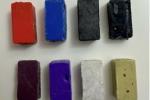SpecOptiBlend: New Open-Source Software for Custom-Colored 3D Printing from Recycled Plastics
Researchers at Canadian Western University have developed open-source software that enables the creation of custom-colored 3D printing filament from recycled plastic waste. Published in Advanced Manufacturing, the study outlines a method that allows users to transform discarded plastics into personalized, affordable feedstock for 3D printing—supporting the field of distributed recycling and additive manufacturing (DRAM).
“The open-source SpecOptiBlend software has shown remarkable effectiveness in producing customized colors from recycled plastics, addressing the prevalent issue of color inconsistency in recycling processes. This enhancement marks a significant step forward in integrating circular economy principles into 3D printing practices,” the study stated.
Compressed waste plastic samples. Photo via: Western University
SpecOptiBlend: Merging Color Theory and Open-Source Design
Kimia Aghamohammadesmaeilketabforoosh, Joshua Givans, Professor Joshua M. Pearce, and Morgan Woods—all affiliated with Western University—have developed an open-source software tool that combines programming and color theory to optimize color matching in 3D printing. This tool, designed for use with Recyclebots—open-source machines that convert waste plastic into filament—empowers users to produce customized filament colors from recycled materials, advancing both sustainability and creativity in additive manufacturing.
The DRAM approach supports decentralized production of personalized goods using recycled plastics and freely available 3D printable designs. DRAM applications range from educational tools and household items to assistive devices, offering a low-cost alternative to traditional consumer goods.
In the study, waste plastics were first analyzed for spectral reflectance after processing, with the Kubelka-Munk theory used to make an initial estimate for color mixing. This process is incorporated into the free software. The Western research team tested three optimization methods: Nelder-Mead, Limited-memory BFGS with bounds, and Sequential Least Squares Quadratic Programming. They assessed the best approach based on criteria such as root mean square (RMS) and color difference (ΔE CIE-2000). The findings indicated that the Nelder-Mead method provided the optimal balance between color precision and RMS, critical for producing high-quality colors.
Reconstruction of the Navy-Blue color using four colors. Image via: Western University
Advances in Multi-Color 3D Printing
In 2021, researchers at Eindhoven University of Technology (TUE) introduced a color-shifting liquid crystal ink compatible with direct ink writing (DIW) 3D printing. Inspired by iridescent surfaces in nature—such as butterfly wings and jewel beetle shells—the ink changes color depending on the viewer’s angle.
This color behavior stems from the ink’s molecular structure. Specifically, the reflective properties are governed by the precise helical alignment of its molecules, which can be manipulated during printing by adjusting parameters like print speed. The TUE team envisions this material being used in applications ranging from decorative lighting and wearable health-monitoring sensors to optics for augmented reality.
In a separate development, scientists at Pacific Northwest National Laboratory (PNNL) created ArtSea Ink, a series of colorful, sustainable bioinks made primarily from seaweed-derived alginate. Alginate is a naturally occurring, biocompatible polymer found in brown seaweed. It’s inexpensive, easy to work with, and can form stable gels without the need for heat—making it ideal for low-temperature 3D printing.
Designed with artistic expression in mind, ArtSea Ink includes eight color variants using 8% alginate solutions combined with mica-based pigments. To demonstrate its versatility, the PNNL team 3D printed a glow-in-the-dark firefly and a vivid blue anatomical model of a human brain—showcasing the material’s potential for both creative and educational uses.
Who won the 2024 3D Printing Industry Awards?
Subscribe to the 3D Printing Industry newsletter to keep up with the latest 3D printing news.
You can also follow us on LinkedIn, and subscribe to the 3D Printing Industry Youtube channel to access more exclusive content.
Featured image shows Compressed waste plastic samples. Photo via: Western University
Paloma Duran
Paloma Duran holds a BA in International Relations and an MA in Journalism. Specializing in writing, podcasting, and content and event creation, she works across politics, energy, mining, and technology. With a passion for global trends, Paloma is particularly interested in the impact of technology like 3D printing on shaping our future.


